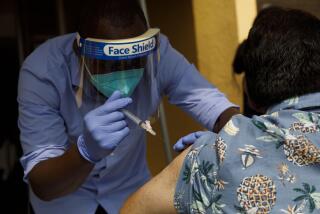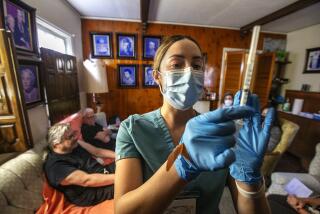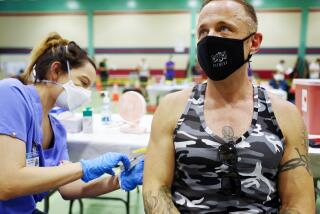Few Volunteer for Smallpox Vaccination
WASHINGTON — The nation’s largest population centers -- home to more than 30 million people -- have vaccinated only 296 front-line health-care workers against smallpox, the deadly disease that the Bush administration has pegged as a top bioterrorist threat.
The big cities, from New York to San Antonio, where the deadly smallpox virus could spread most easily and quickly, are proving to be among the hardest places to build a cadre of health-care workers prepared to respond to an outbreak.
For the record:
12:00 a.m. March 19, 2003 For The Record
Los Angeles Times Wednesday March 19, 2003 Home Edition Main News Part A Page 2 National Desk 0 inches; 27 words Type of Material: Correction
Smallpox--A March 14 article in Section A about smallpox vaccinations misidentified the public health officer of San Diego County. She is Dr. Nancy Bowen, not Mary Bowen.
Some administration officials are particularly angry that so few have volunteered. For every health-care worker who chooses not to be vaccinated, said an official who spoke on condition of anonymity, “more people will die in case of an attack.”
On Wednesday, federal health officials remained perplexed as to why their high-profile anti-terrorism campaign had failed to catch on.
“We’ve been putting a lot of eggs in the vaccination basket and it hasn’t gotten us a lot,” said Joseph Henderson, associate director of terrorism preparedness and response at the national Centers for Disease Control and Prevention. “Right now, the vulnerability persists.”
The administration tried last week to address one major concern: the fears of health-care workers that they would not be compensated for medical bills or sick time that could result from negative reactions to the vaccine. But the administration’s proposed compensation package, now moving through Congress, appears to have had little immediate effect on workers’ willingness to roll up their sleeves -- perhaps because, as administration officials now concede, they have overstated the vaccine’s risk.
In addition, many nurses and doctors remain unconvinced that smallpox -- a disease not seen in the United States since 1949 and eradicated worldwide in 1980 -- could again become a major health threat.
Others want to volunteer, local officials say, but find themselves disqualified by health problems -- a history of eczema, for example -- that make the vaccine especially risky for them.
When the vaccination program began Jan. 24, the administration said its goal was to vaccinate 450,000 front-line health-care workers -- the doctors and nurses who, in case of a bioterrorist attack, would investigate suspected smallpox cases, treat the victims, track down their friends and relatives and administer the vaccine.
Nationwide, only 16,919 people had been vaccinated by March 7, according to CDC figures released Thursday.
The Times surveyed Los Angeles County, where the numbers include the city of Los Angeles, and the eight other largest cities in the U.S.
In Los Angeles County, 115 workers had been vaccinated. The numbers in other cities ranged from none in Phoenix to 53 in San Antonio; New York City had vaccinated 41.
In Houston, where just 18 public-health workers had been vaccinated by Tuesday, officials decided last month to try to attract health-care workers from outside the city department.
They sent out a news release and did interviews with local media; next week, officials will begin vaccinating the 119 health-care workers who signed up with the city to receive the vaccine and then be trained to vaccinate others.
“We did not want to wait for the crisis,” said Kathy Barton, spokeswoman for the Houston Department of Health and Human Services. “I don’t know how you could do it if you had to vaccinate an entire population in 10 days.”
In Phoenix, the Maricopa County Health Department has decided to vaccinate “no more than 20” people, said Dr. Lawrence Sands, the agency’s medical director for epidemiology and bioterrorism response preparedness. “There are no cases of smallpox in the world,” Sands said, explaining his decision. “There is no credible threat of disease. Right now, the risks of vaccination are greater than the risks of disease.”
Chicago has vaccinated 18 workers in its public health department, out of about 100 who are eligible. However, it has yet to vaccinate anyone at any of its 34 hospitals, each of which has 100 or more candidates. Officials said they expect one-half to two-thirds of the hospitals to eventually decide to participate in the vaccination program.
The New York City Department of Health and Mental Hygiene, by contrast, is working with almost 70 hospitals, said Dr. Jane Zucker, medical director of the agency’s immunization division. Although it has vaccinated only 41 of its own workers so far, the health department plans to inoculate 5,000 to 10,000 nurses, doctors and other response-team members by the end of May, she said.
In San Antonio, 56 health-care workers have been vaccinated.
In San Diego, where officials are “bending over backward” to explain the risks of the vaccine, many would-be volunteers are being screened out due to personal health conditions, said Dr. Mary Bowen, public health officer for San Diego County.
Some officials are trying to put the vaccine’s risks in perspective. “A person’s average chance of dying in an accidental injury is 1 in 3,000 every year,” said Dr. Jonathan Fielding, director of the Los Angeles County Department of Health Services. “Compare that to the 1-in-a-million chance of dying from a smallpox vaccine.”
Roughly half of the 115 people vaccinated in Los Angeles County’s department work at area hospitals; the others are public-health workers, FBI agents and a few journalists, Fielding said. He still hopes to draw more hospitals into the program and is reaching out to retired doctors to become vaccinators.
“Always, the more the better, but there’s no magic number,” he said. “It’s unrealistic that we alone could ever vaccinate the entire population in a few days,” but surrounding counties, state and federal authorities would also rush in to help, he predicted.
Federal officials in Washington have all but begged health-care workers to volunteer by appealing to their patriotism and ratcheting up their language about the threat of attack.
This week, they expanded the PR campaign, publicly inoculating Surgeon General Richard H. Carmona, CDC Director Julie L. Gerberding and even Dr. D.A. Henderson, the much-vaccinated man who led the global campaign to wipe out smallpox.
Health and Human Services Secretary Tommy G. Thompson said last week that officials were studying where those vaccinated are -- and aren’t -- so they could quickly move additional inoculated health workers to any area that reports a case of smallpox.
Toward that end, they have begun to vaccinate “many hundreds” of CDC staff and members of the surgeon general’s Public Health Service Commission Corps, they said.
More to Read
Sign up for Essential California
The most important California stories and recommendations in your inbox every morning.
You may occasionally receive promotional content from the Los Angeles Times.










